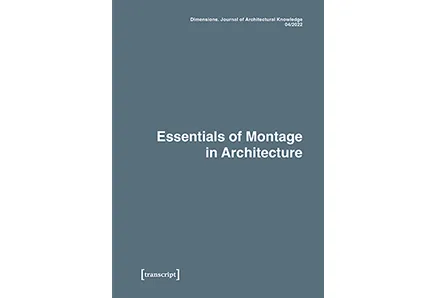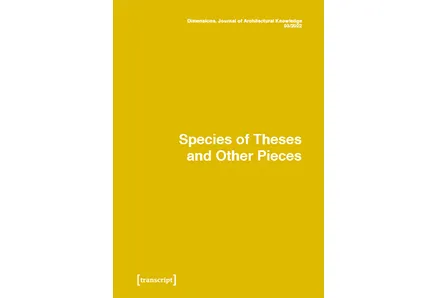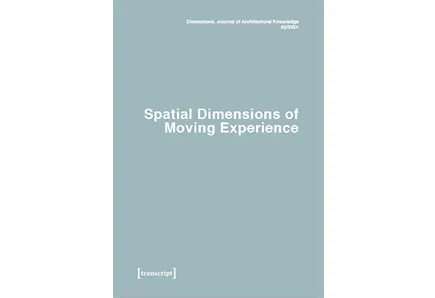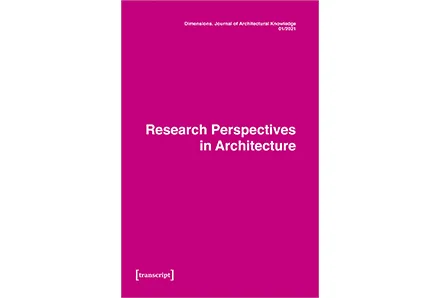
Journal
DIMENSIONS. Journal of Architectural Knowledge
is an international, peer-reviewed journal initiated in the context of the BauHow5 European Alliance for Architecture and the Built Environment and their associated networks. It addresses design as the core of the architecture discipline and investigates the creation, constitution and sharing of architectural knowledge. The aim of the journal is to explore processes, procedures and results from practice and research with particular attentiveness to the architectural design and to investigate epistemologies of aesthetic practices and research.
DIMENSIONS assembles contributions referring to the constitution and body of knowledge in architecture, aiming to exploit specific architectural knowledge, its mediation, investigation and research.
Twice a year DIMENSIONS publishes curated editions on superordinate subject. Calls are launched publically and contributions to the thematic framing of the respective edition are selected in a double-blind peer review procedure. The editions are published in print and Open Access. Beyond the curated editions with thematically framed fields, DIMENSIONS provides a platform to publish all kinds of investigation and research on architectural knowledge, its particularities, the creation, providing and mediation of it as well as its discourse within the principle objective of the journal. These singular contributions addressing the constitution and the body of knowledge in architecture are published Open Access only, in the context of the digital archive of transcript.open.
The notion of dimensions refers to the multidirectional nature of impacts and subject areas of the architectural discipline, including architectural design, construction and technology, landscape architecture, urban planning and design, history and theory of architecture as well as affinities to other fields in interdisciplinary investigation.
Essentials of Montage in Architecture
»Essentials of Montage in Architecture«, Issue 04/2022, is edited by Max Treiber, Sandra Meireis and Julian Franke and aims to conduct a discourse that provides a comprehensive collection of theories, methods, and visions to highlight the relevance of montage for visual and spatial practices as well as for knowledge production in architecture. It invites theorists and practitioners from different disciplines to reflect upon various aspects of »Montage in Architecture« and to present their specific observations gained in research, practice, or teaching. This issue’s overarching objective is to bring together investigations from different disciplines – i.e. foremost Architecture and Urban Design, Photography and Writing, but also Philosophy, Sociology, and other fields – to widen the perspective on montage in the architectural discourse.
In addition to full paper contributions, this call is explicitly open and unrestricted concerning the methods of practice-related investigations and research. Contributors are thus welcomed to assemble observations in the mode of visual contributions (documentations or any other form of notation).
We are looking forward to receive your contributions until February 28, 2022 at mail(at)dimensions-journal.eu

Species of Theses and Other Pieces
»Species of Theses and Other Pieces«, Issue 03/2022, edited by Meike Schalk, Torsten Lange, Andreas Putz, and Tijana Stevanovic, is concerned with practice-oriented research. The term »thesis« comes from the Greek meaning »something put forth«, and refers to a proposition. How we know is as much mediated through the thesis’ form as it is through its content. The title of this issue is borrowed from Species of Spaces and Other Pieces by George Perec (1974). In reference to Perec, »Species of Theses« takes the love for playing with forms, genres, and arrangements as its program. The appropriation of specific formats or modes of representation (such as an archive, exhibition, performance) can prompt imagining other ways of performing research, and communicating findings with diverse audiences.
We are looking forward to receive your Full Paper contributions until September 15, 2021

Spatial Dimensions of Moving Experience
»Spatial Dimensions of Moving Experience«, Issue 02/2021, is edited by Virginie Roy and Katharina Voigt and investigates lived experience as source for the constitution of knowledge.
This edition is concerned with the movements of exploration and the inner sensations of being moved by experience. We are looking for contributions that investigate tangible observations, which either emerge from the actual experience, or are connected to the memory or imagination of experiential events. Practitioners and scholars from various disciplines are invited, to open the realm of discussion for theoretical, applied, and practice-related forms of research. All contributions are aligned to enrich the discourse of architecture and its versatile dimensions.
This issue’s overarching objective is to bring together investigations from different disciplines (i.e. foremost Architecture and Dance, but also Anthropology, Ethnology, Philosophy, Sociology et al.) to contribute to the architectural discourse. We cordially invite researchers, practitioners and theorists to contribute to this edition.
We are looking forward to receive your Full Paper contributions until July 15, 2021

Research Perspectives in Architecture
Katharina Voigt, Uta Graff and Ferdinand Ludwig (eds.)
Issue 01/2020, Englisch, Format 15,2 x 22,9 cm, 248 Seiten, published at transcript Academic Publishing, Bielefeld 2021. ISBN 978-3-8376-5809-5, ISSN 2747-5085, eISSN 2747-5093.
»Research Perspectives in Architecture« investigates methodologies and ways of working, contributing to the creation and constitution of knowledge in the discipline of architecture. This first curated edition explores different lines of enquiry with specific focus on their methodology. Design-based, reflexive, qualitative, experience-based, archival and interdisciplinary perspectives are investigated.
